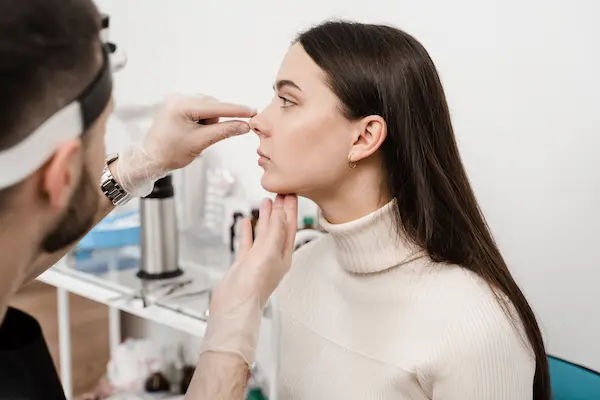Septoplasty: Relief for a Deviated Septum
Learn how septoplasty can correct a deviated septum, relieve nasal obstruction, and improve your breathing.


Introduction
Struggling with a constantly stuffy nose, even when you don't have a cold? Do you find yourself breathing through one nostril more than the other? You might be among the millions of people living with a deviated septum, a common condition where the thin wall between your nasal passages is displaced. For many, it's a minor nuisance, but for others, it can significantly impact quality of life, leading to chronic sinus infections, snoring, and sleep disturbances. This comprehensive guide delves into septoplasty, the surgical procedure designed to correct this issue. We will walk you through everything from understanding the symptoms and diagnosis to the intricate details of the surgery and the crucial recovery period. Our goal is to empower you with the knowledge you need to have an informed discussion with your doctor and decide if septoplasty is the right path to help you breathe freely again.
Understanding the Nasal Septum: The Root of the Problem
Before we explore the solution, it's essential to understand the anatomy involved. The nasal septum is the central divider of your nose, made of cartilage in the front and thin bone further back. Ideally, it sits perfectly centred, allowing for equal airflow through both nostrils.
What is a Deviated Septum?
A deviated septum occurs when this nasal septum is crooked or shifted to one side. It's surprisingly common; estimates suggest that as many as 80% of people have some degree of deviation, though many are unaware of it. A deviation can be a simple C-shaped curve, an S-shaped curve, or can include bony spurs that project into the nasal airway. The severity of the deviation directly correlates with the severity of symptoms. A minor deviation might cause no issues, while a significant one can block one side of the nose entirely.
Common Causes of a Deviated Septum
Deviations are typically categorised into two types: congenital and acquired.
• Congenital: Some people are simply born with a deviated septum. It can occur during fetal development or as a result of mild trauma during the birth process.
• Acquired: This is the most common cause and involves injury to the nose. This nasal trauma can range from a major event like a car accident or a sports injury to something as simple as a rough tumble during childhood. It's important to note that the injury could have happened years before symptoms became noticeable.
Is It Just a Stuffy Nose? Recognising the Symptoms
How can you tell if your nasal congestion is due to a deviated septum or just allergies? The key differentiator is persistence. While allergies and colds come and go, the symptoms of a deviated septum are constant.
Primary Symptoms: Beyond Nasal Congestion
The most obvious sign is nasal obstruction or congestion, often worse on one side. This can lead to:
• Difficulty Breathing: A persistent feeling of being unable to draw a full breath through your nose.
• Recurrent Nosebleeds: The deviation can cause airflow to dry out one side of the nose, leading to crusting and bleeding.
• Facial Pain: A sense of pressure or pain in the face, often mistaken for sinus headaches.
• Noisy Breathing: Audible breathing, especially during sleep, due to turbulent air passing through the narrowed passage.
Secondary Complications: When to Be Concerned
When left unaddressed, a deviated septum can lead to more serious issues. The blocked airflow can prevent proper sinus drainage, making you more prone to recurrent sinus infections (sinusitis). It is also a leading cause of loud snoring and can contribute to sleep apnea, a serious condition where breathing repeatedly stops and starts during sleep, leading to chronic fatigue and other health risks. If your condition does not improve after trying standard decongestants, consult a doctor online with Apollo24|7 for further evaluation.
Consult an ENT Specialist for the best advice
Are You a Candidate for Septoplasty?
Not everyone with a deviated septum needs surgery. The decision is based on how significantly the deviation impacts your daily life.
Medical Evaluation and Diagnosis
Your journey begins with a visit to an Ear, Nose, and Throat (ENT) specialist. The diagnosis is often straightforward. The doctor will use a simple tool called a nasal speculum to gently open your nostrils and visually examine the septum. In some cases, they may use a small camera (nasal endoscope) for a more detailed view. They will ask about your symptoms, their duration, and what, if anything, provides relief.
Non-Surgical Options to Try First
Surgery is typically considered only after conservative treatments have failed. Your doctor will likely recommend you try:
• Decongestants: To reduce nasal tissue swelling and improve airflow.
• Antihistamines: To manage allergy symptoms that can compound the blockage.
• Nasal Steroid Sprays: To decrease inflammation in the nasal passages.
These deviated septum treatments can manage symptoms effectively but do not correct the underlying structural issue. If these methods don't provide adequate relief, septoplasty becomes a viable option.
The Septoplasty Procedure: A Step-by-Step Walkthrough
Understanding what happens during the procedure can alleviate much of the anxiety associated with it.
Pre-Operative Preparation: What to Expect
Once you and your surgeon decide to proceed, you'll receive pre-operative instructions. This may include stopping certain medications (like blood thinners), avoiding smoking, and arranging for someone to drive you home after the surgery.
The Day of Surgery: Anaesthesia and Techniques
Septoplasty is usually an outpatient procedure, meaning you go home the same day. It is performed under general anaesthesia (you're asleep) or local anaesthesia with sedation (you're awake but drowsy and your nose is numb). The surgeon makes a small incision inside the nostril to access the septum. The key step involves lifting the mucous membrane lining, straightening or removing the bent cartilage and bone, and then repositioning the lining. The entire surgery typically takes 30 to 90 minutes.
Functional Septoplasty vs. Rhinoplasty: What's the Difference?
This is a crucial distinction. A septoplasty is a functional procedure focused solely on improving airflow by correcting the internal septum. A rhinoplasty is a cosmetic procedure that changes the external shape of the nose. Often, the two can be combined in a single operation known as a "septorhinoplasty," which addresses both breathing function and the nose's appearance.
The Recovery Journey: What to Expect Week by Week
Patience is the most important virtue during septoplasty recovery. Full healing is a gradual process.
The First 72 Hours: The Most Critical Phase
You will likely have nasal packing or soft silicone splints/stents inside your nose to support the new structure and minimise bleeding. You will breathe through your mouth during this time. Expect swelling, mild discomfort, and drainage. Your doctor will prescribe pain medication. Applying cold compresses and keeping your head elevated, even while sleeping, is crucial to reduce swelling.
Week 1-2: Managing Discomfort and Stent Removal
Most people can return to sedentary work or school after the first week. The most significant milestone is the removal of the splints, usually around 5-7 days post-surgery. This provides immediate relief and a noticeable improvement in breathing, though some internal swelling remains. You'll be instructed to use saline nasal sprays frequently to keep the area moist and prevent crusting.
Weeks 3-6: Returning to Normalcy and Final Results
Swelling continues to subside. You can gradually resume light exercise. While breathing improves dramatically after stent removal, the final result may take 3-6 months as the last bits of internal swelling resolve. The tissues need time to settle completely, revealing the full benefit of the surgery.
Risks and Benefits: Making an Informed Decision
Like any surgery, septoplasty carries risks, but they are relatively rare.
Risks: Include bleeding, infection, reaction to anaesthesia, changes in sense of smell, persistent numbness, or a small chance that the septum could deviate again, requiring revision surgery.
Benefits: For the vast majority, the benefits are life-changing: significantly improved nasal breathing, reduced sinus infections, better sleep quality, and decreased snoring. The decision hinges on whether the potential benefits outweigh the risks for your specific situation.
Cost, Insurance, and Finding the Right Surgeon
The cost of septoplasty varies widely based on geographic location, surgeon's experience, and facility fees. A key factor is insurance. Because it is considered a medically necessary procedure to correct a functional impairment, it is often covered by health insurance, though you will be responsible for deductibles and co-pays. Pre-authorisation is usually required. When choosing a surgeon, select a board-certified ENT specialist with extensive experience in nasal surgeries.
Conclusion: Breathing Easy Again
Living with a chronically blocked nose can be more than just an inconvenience; it can diminish your energy, disrupt your sleep, and affect your overall well-being. Septoplasty offers a highly effective, permanent solution for those whose quality of life is impacted by a deviated septum. By understanding the procedure, the realistic recovery timeline, and the potential risks and benefits, you can move forward with confidence. If the symptoms we've discussed resonate with you, take the next step.
Consult an ENT Specialist for the best advice
Consult an ENT Specialist for the best advice

Dr. Riya Das
Ent Specialist
8 Years • MBBS, MS ENT(oto rhino laryngology)
East Midnapore
VIVEKANANDA SEBA SADAN, East Midnapore

Dr Vaishnavi Shetty
Ent Specialist
5 Years • M. B. B. S , M.S.Otorhinolaryngology
Bengaluru
Apollo Medical Center, Marathahalli, Bengaluru

Dr. Mayur Nair
Ent Specialist
11 Years • MBBS, MS - ENT
Bengaluru
Apollo Clinic, Sarjapur Road, Bengaluru

Dr. Sayan Hazra
Ent Specialist
8 Years • MBBS, MS (ENT), DNB (ENT)
Kolkata
Dr Sayan Hazra ENT Clinic, Kolkata

Dr. Athira Raj
Ent Specialist
6 Years • MBBS , MS ENT
Bangalore
Apollo Clinic Bellandur, Bangalore
Consult an ENT Specialist for the best advice

Dr. Riya Das
Ent Specialist
8 Years • MBBS, MS ENT(oto rhino laryngology)
East Midnapore
VIVEKANANDA SEBA SADAN, East Midnapore

Dr Vaishnavi Shetty
Ent Specialist
5 Years • M. B. B. S , M.S.Otorhinolaryngology
Bengaluru
Apollo Medical Center, Marathahalli, Bengaluru

Dr. Mayur Nair
Ent Specialist
11 Years • MBBS, MS - ENT
Bengaluru
Apollo Clinic, Sarjapur Road, Bengaluru

Dr. Sayan Hazra
Ent Specialist
8 Years • MBBS, MS (ENT), DNB (ENT)
Kolkata
Dr Sayan Hazra ENT Clinic, Kolkata

Dr. Athira Raj
Ent Specialist
6 Years • MBBS , MS ENT
Bangalore
Apollo Clinic Bellandur, Bangalore
More articles from Deviated septum
Frequently Asked Questions
1. Will septoplasty change the shape of my nose?
In most cases, no. A standard functional septoplasty is performed entirely inside the nose, so there is no change to the external shape. However, if a significant amount of cartilage is removed, a slight change in the bridge or tip is possible but usually not noticeable.
2. How painful is septoplasty recovery?
Most patients describe the recovery as uncomfortable rather than intensely painful. The sensation is often compared to having a severe head cold with significant congestion. Pain is typically well-managed with prescribed medication for the first few days.
3. Is septoplasty a permanent fix?
Yes, the correction is considered permanent. The straightened cartilage and bone should remain in place. However, a new injury to the nose could potentially cause another deviation.
4. When can I blow my nose after surgery?
You must avoid blowing your nose for at least the first week to prevent bleeding and disruption of the healing tissues. Your surgeon will give you specific instructions on when it is safe to resume, usually after your first post-op check-up.
5. Can septoplasty cure sleep apnea?
While not a cure for obstructive sleep apnoea (OSA), which has multiple causes, septoplasty can be a very effective part of the treatment plan. By relieving nasal obstruction, it can reduce snoring and improve the effectiveness of other treatments like CPAP machines.
